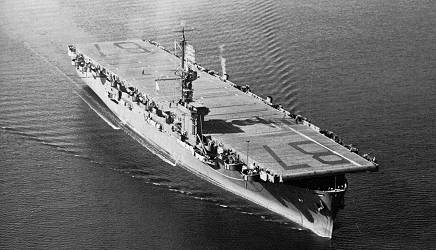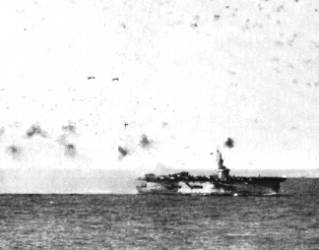

 |
Search the Site with

|
 | Sorry, no coat of arms available. |
USS STEAMER BAY was the 33rd CASABLANCA - class escort aircraft carrier. Decommissioned on July 1, 1946, the STEAMER BAY was placed in the Atlantic Reserve Fleet, Boston. The ship was re-classified CVHE 87 on June 12, 1955. The STEAMER BAY was stricken from the Navy list on March 1, 1959, and was sold to Hyman-Michaels Co. of Chicago on August 29, 1959, for scrap.
| General Characteristics: | Awarded: 1942 |
| Keel laid: December 4, 1943 | |
| Launched: February 26, 1944 | |
| Commissioned: April 4, 1944 | |
| Decommissioned: July 1, 1946 | |
| Builder: Kaiser Shipbuilding Co., Vancouver, Wash. | |
| Propulsion system: four boilers | |
| Propellers: two | |
| Length: 512.5 feet (156.2 meters) | |
| Flight Deck Width: 108 feet (32.9 meters) | |
| Beam: 65 feet (19.9 meters) | |
| Draft: 22.6 feet (6.9 meters) | |
| Displacement: approx. 10,400 tons full load | |
| Speed: 19 knots | |
| Catapults: one | |
| Aircraft: 28 planes | |
| Armament: one 5-inch L/38 gun, 16 40mm guns, 20 20mm guns | |
| Crew: 860 |
Crew List:
This section contains the names of sailors who served aboard USS STEAMER BAY. It is no official listing but contains the names of sailors who submitted their information.
Embarked Squadrons:
| Period | Squadron (Aircraft) |
|---|---|
| March 1944 | VC-83 (4 FM, 8 F4F and 8 TBF/TBM) |
| December 1944 - February 1945 | VC-90 (16 FM and 12 TBM) |
| March - May 1945 | VC-90 (19 FM and 12 TBM) |
History of USS STEAMER BAY:
STEAMER BAY, ex-MC hull 1124, was laid down on 4 December 1943 at Vancouver, Wash., by the Kaiser Shipbuilding Co.; launched on 26 February 1944; sponsored by Mrs. Henry S. Kendall; and commissioned on 4 April 1944, Capt. Steadman Teller in command.
STEAMER BAY held sea trials in Puget Sound and sailed for San Diego on 2 May. On the 14th, she headed for the New Hebrides, carrying the men and aircraft of Marine Air Group (MAG) 61. She arrived at Espiritu Santo on the 30th, unloaded, and began her return voyage to San Diego on 2 June. The carrier was on the west coast from 20 June to 19 July when she again steamed west with 298 marines and 72 aircraft, bound for the Marshall Islands.
STEAMER BAY arrived at Majuro on 1 August to discharge her cargo and passengers. She was routed back to Pearl Harbor and attached to the 3rd Fleet as a carrier of replacement aircraft. Seventy-two planes were loaded on board; and the ship steamed for Seeadler Harbor, Manus Island, on 21 August. During the next two and one-half months, the carrier supplied replacement aircraft and pilots to Task Force (TF) 38 which was supporting the operations in the Palau and Philippine Islands. She spent the period from 15 November to 5 December at Pearl Harbor undergoing repairs and training. The ship returned to Seeadler Harbor on 17 December and was assigned to Task Group (TG) 77.4, the San Fabian Carrier Group, which sortied on 1 January 1945. The group (Taffey 2), consisting of six escort carriers under the command of Rear Admiral F. B. Stump, supported the Lingayen landings. While steaming through the Sulu and South China seas toward the Lingayen beaches, during the first week of January 1945, the group was the target of numerous enemy air attacks. Of the six carriers, OMMANEY BAY (CVE 79) was sunk on 4 January by a kamikaze plane; and MANILA BAY (CVE 61) and SAVO ISLAND (CVE 78) were damaged the next day. During the landings, the CVE's launched over 1,400 aircraft sorties in support of ground forces. STEAMER BAY remained in the Philippine Islands with the 7th Fleet until she got underway on 31 January for Ulithi.
The group (Taffey 2), consisting of six escort carriers under the command of Rear Admiral F. B. Stump, supported the Lingayen landings. While steaming through the Sulu and South China seas toward the Lingayen beaches, during the first week of January 1945, the group was the target of numerous enemy air attacks. Of the six carriers, OMMANEY BAY (CVE 79) was sunk on 4 January by a kamikaze plane; and MANILA BAY (CVE 61) and SAVO ISLAND (CVE 78) were damaged the next day. During the landings, the CVE's launched over 1,400 aircraft sorties in support of ground forces. STEAMER BAY remained in the Philippine Islands with the 7th Fleet until she got underway on 31 January for Ulithi.
STEAMER BAY anchored there from 5 to 10 February when she departed with units of the 5th Fleet for the invasion of Iwo Jima. She was with four other escort carriers which arrived at their assigned area of operations, 50 miles west of Iwo Jima, on 16 February. Their mission was to neutralize Japanese bases in the Nanpo Shoto until 19 February (D-Day) and then provide air cover and direct support for the marines during the landings and the struggle for the strategic island.
STEAMER BAY was relieved on 7 March and arrived at San Pedro Bay, Leyte, on the 12th. She sailed for the Ryukyus on 27 March and arrived in the operating area south of Okinawa on the morning of 1 April. She remained off Okinawa until 26 May when she sailed to Apra Harbor, Guam, for repairs. On 10 June, the carrier was ordered to join the 3rd Fleet east of Miyako Jima and assist in neutralizing Japanese air fields in Sakishima Gunto. She conducted air strikes against the fields from 14 to 22 June when she sailed for Ulithi.
STEAMER BAY stood out of Ulithi, on 3 July, with the Logistics Support Group resupplying the fast carrier forces during operations against the Japanese mainland. On the 20th, she was detached and sailed, via Guam and Pearl Harbor, for the west coast, arriving at San Diego on 10 August.
STEAMER BAY was in drydock when hostilities with Japan ended, and she was given additional bunks to accommodate veterans returning from overseas. She sailed for Pearl Harbor, on 28 September, on her first "Magic Carpet" assignment.
STEAMER BAY was assigned to the Pacific Reserve Fleet on 4 February 1946 and berthed at Tacoma, Wash. In January 1947, she was placed in reserve, out of commission. Her designation was changed from CVE 87 to CVHE 87 on 12 June 1955. The carrier was struck from the Navy list on 1 March 1959 and sold to Hyman-Michaels Co., Chicago, Ill., on 29 August 1959 for scrap.
STEAMER BAY received six battle stars for World War II service.
USS STEAMER BAY Image Gallery:
 |
 Back to Escort Carrier List.
Back to Escort Carrier List.  Back to Ships List.
Back to Ships List.  Back to selection page.
Back to selection page.  Back to 1st page.
Back to 1st page.